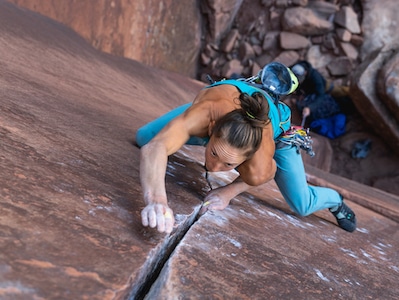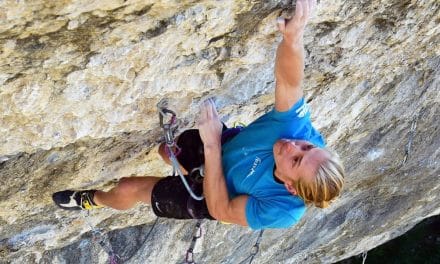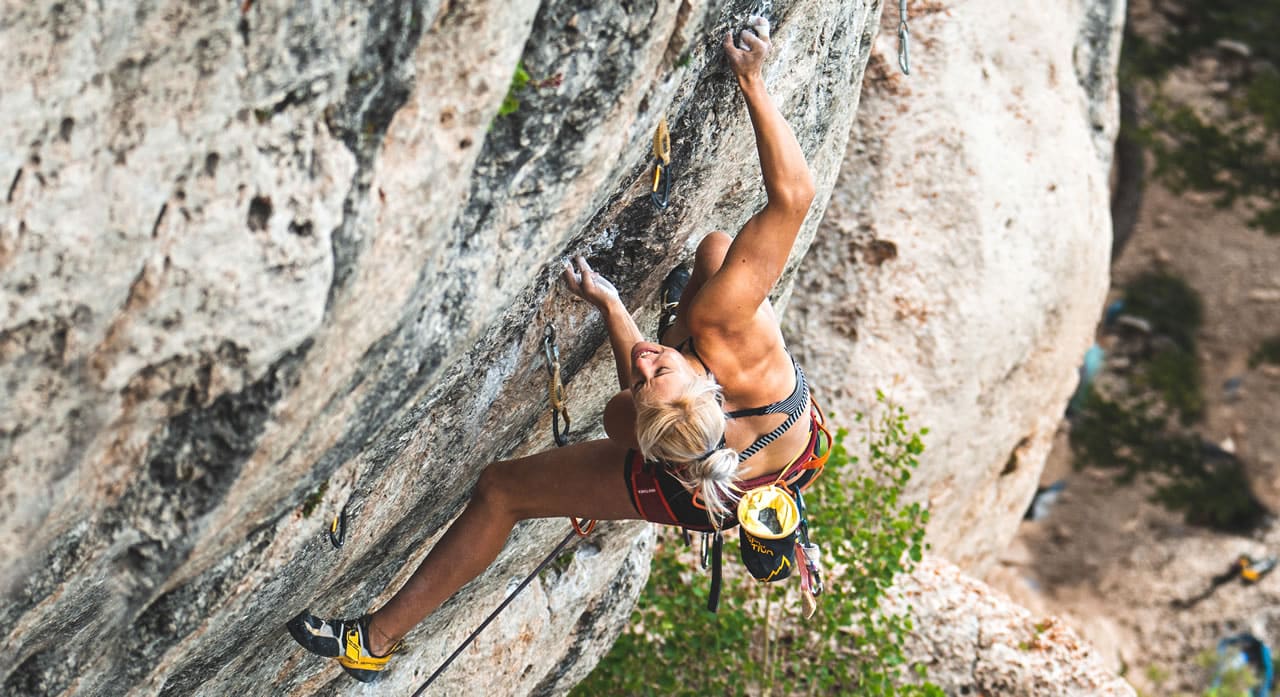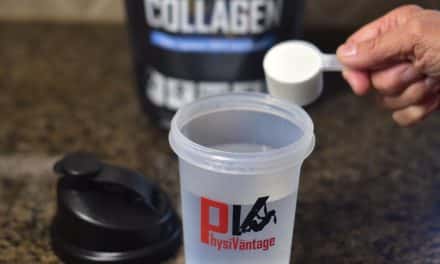Climbing well on hot days at the crag requires giving your body what it needs to withstand the elements. Hydrate to be great on the wall this summer season.
In case you haven’t noticed, it’s a scorcher out there. Summer has descended upon us in full-force. The changing of the seasons gives way to two of a climber’s favorite things: dry rock and late sunsets. Nothing worth having comes easy, though… so we pay the price in the form of a climber’s worst enemy: sweat.
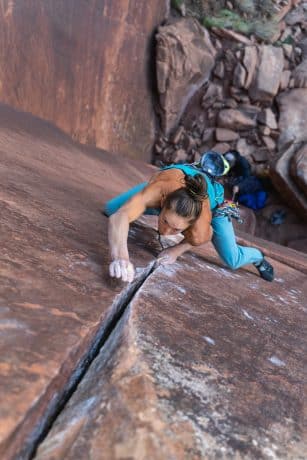
Amity Warme staying cool and collected thanks to smart hydration.
It’s a trade-off that most of us are willing (if not eager) to make. But without proper planning, sweating in the summer heat really can make or break your crag day. It’s more than a matter of annoyance. Sweat doesn’t just send you greasing off of every hold on your project; it can also lead to dehydration that hinders both muscle functioning and brain activity. Amity Warme, PhysiVantage athlete and sports dietitian for climbers, warns that “losing 1-2% of body weight from fluid loss during exercise is enough to cause a decline in mental and physical performance”.
Nothing speeds up the pump clock than a lack of fluid available to your hardworking, parched muscles. Not only that, the mood swings alone will send your belayer packing faster than you can crack open your dry lips to cry “take!”. The effects can even continue to haunt you once you’re back in the loving arms of your air conditioning unit. Headaches, dizziness, GI distress, fatigue, emotional dysregulation, and poor or delayed recovery might linger for days after a bad bout of dehydration. There’s more than just performance in the present moment at stake.
The good news is that climbers can take steps to navigate the threats that sweat poses for health and performance so it doesn’t become such a buzz-kill, in the moment or in the aftermath. Treat crag day hydration with the same intentionality as your nutrition. Together, they’re your best fuel for putting in your best efforts and enduring the environment you’re in.
Drink Early and Often
Don’t wait until you’re already thirsty to start hydrating. Just like with nutrition, it’s better to go in with a full tank than on a half-empty one. Start by drinking at least 16-20 ounces of water as soon as your alarm goes off in the morning—bonus points if you get it down your gullet before your feet even touch the floor! Eight hours (or more, for all you chronically exhausted athletes) is a long time to go without fluids. An initial dose of hydration immediately upon waking helps preemptively lubricate the system so your gears run smoothly for the rest of the day.
But don’t stop there. It doesn’t take long for working hard in hot temps to drain the tank again. You’d be wise to avoid getting remotely close to that point. It’s much harder to fight back against dehydration once it’s already set in than it is to preempt it. Aim to rehydrate every hour you’re out in the elements, adding in a few extra gulps before each pitch to promote blood flow and prevent pumping out on the wall. Set a timer if you need the reminder. Thirst isn’t always the best gauge for an athlete’s hydration needs. Hours of activity tend to dull the senses so the more subtle signs of dehydration go unnoticed until you’re already in the hole. A steady stream of fluid throughout the day, no matter what, is your best bet for warding off the worst of dehydration.
Set a Hydration Goal
A couple sips here and there won’t cut it, though. Neither will chugging an entire liter every five minutes. Too little water cuts in your performance, yes, but too much could easily weigh you down. Set a hydration goal for the day that’s effective and realistic. Start with this rough guideline: half your weight in ounces, plus 8-16 ounces for every hour at the crag. Work toward the upper end of that spectrum the hotter and sunnier it gets. If you’re a morning coffee drinker or a fan of the post-climb beer, add the equivalent amount of water into your total. Both caffeine and alcohol act as diuretics, which speed the flow of fluid through your body. While this might sound like a positive thing, it usually results in more liquid leaving your body via urination than feeding your muscles and organs.
Once you have an idea of your hydration goal, set yourself up for success in actually consuming it all. I like to bring along one big reservoir (like the HydraPak Seeker) that contains my entire allotment of liquid for the day. That way, I don’t have to count cups, ounces, or bottles as I go. All I need to worry about is emptying that reservoir by the time I get back to the car.
Another way to gauge your hydration level is to get up close and personal with your pee. Warme explains that “a light straw or lemonade color indicates proper hydration while a dark yellow indicates dehydration and completely clear is overhydration”. Keep tabs on the color throughout the day and adjust your hydration accordingly.
Supplement with Electrolytes
Flow from PhysiVantage helps climbers with their hydration thanks to the ideal electrolyte balance for climbing-specific demands on the body.
When formulating those hydration goals, think beyond plain water. When you’re sweating and exerting energy, you’re not just losing fluids; you’re burning through electrolytes too. “Electrolytes help with fluid balance and regulation as well as proper muscle contraction and relaxation,” explains Warme. Think of these minerals as the map that tells the fluids where to go. They’re also the doorman that lets them in at their final destination. Without electrolytes, water can’t do its job.
Now, climbers don’t typically sweat quite as much as your average runner. That means we don’t lose as much of some electrolytes, like sodium. At the same time, we’re often using more of other electrolytes, like magnesium, through muscular exertion. Our electrolyte needs, then, differ from those of other athletes. Flow, PhysiVantage’s take on hydration support, takes the specific demands of climbing into account for its electrolyte formula. There’s little benefit in overloading on the electrolytes you don’t need at the expense of the ones you do. With Flow, climbers can prime their bodies with the most applicable fluid composition from the start.
Like anything in climbing, intention is everything when it comes to smart hydration. Know your needs, plot out your goals, and chip away at them throughout each day at the crag. Drink up!
Related Articles:
- Fueling for Sending with Amity Warme, Sports Dietitian
- Performance Nutrition Through the Lens of Top Pro Climbers
- Benefits of Supplemental Protein for Climbers
- Boulder and Crag Day Climbing Nutrition for Peak Performance
- How to Develop Stronger, Healthier Fingers and Tendons for Climbing
Copyright © 2000–2023 Lucie Hanes & Eric J. Hörst | All Rights Reserved.

